I’m sleep-deprived, caffeine-fuelled and alone in the car, but I just can’t hold back the grin as it spreads itself across my face. I’m almost trembling with an-ti-ci-pa-tion! It’s been less than twelve hours since I pinpointed the location to my latest haikyo crush, but I just couldn’t wait to explore this one.
Only a hundred or so of this house were ever produced worldwide, so if I’m right this ruin will turn out to be something pretty special. The satellite imagery seems to confirm what all the clues from my hours of research at the library have led me to believe, but I’m still not completely sure I’ve got the right place.
This has to be it, right!? What else is a circular building gonna be?
(Don’t say water repository…)

I know, I know. Your time is valuable. And If I’m following conventions I should probably give you more than a grainy image of a circular blob. Still, grab a coffee, join the journey and indulge me a little.
Well, a lot. This is a long story!
We have a three hour drive until I can confirm the truth, and a whole heap of backstory to fill you in on before we get there!
Trust me though, you’ll enjoy it.
Japan’s Twin Futuro
I’m sure you’re thinking – what’s a Futuro!? If you’re not, well you already know what we’re setting out to find. But if you’re as clueless as I was when I first heard the word, don’t go searching for it just yet. We’ll get to the big reveal soon enough! Let me recount what I know as we drive towards our destination.
I first learnt about Futuro a couple of years ago. Basically small, circular houses made of plastic that were shipped all over the world during the seventies – including two that were imported to Japan. At that time I promptly marked the location of one of them on my trusty haikyo map. The only problem? It wasn’t a ruin! The Maebashi Futuro is situated in the car park of the Felcia Architecture and Design College – a rather fitting resting place for such an object, I think. You can see it gleaming there below.
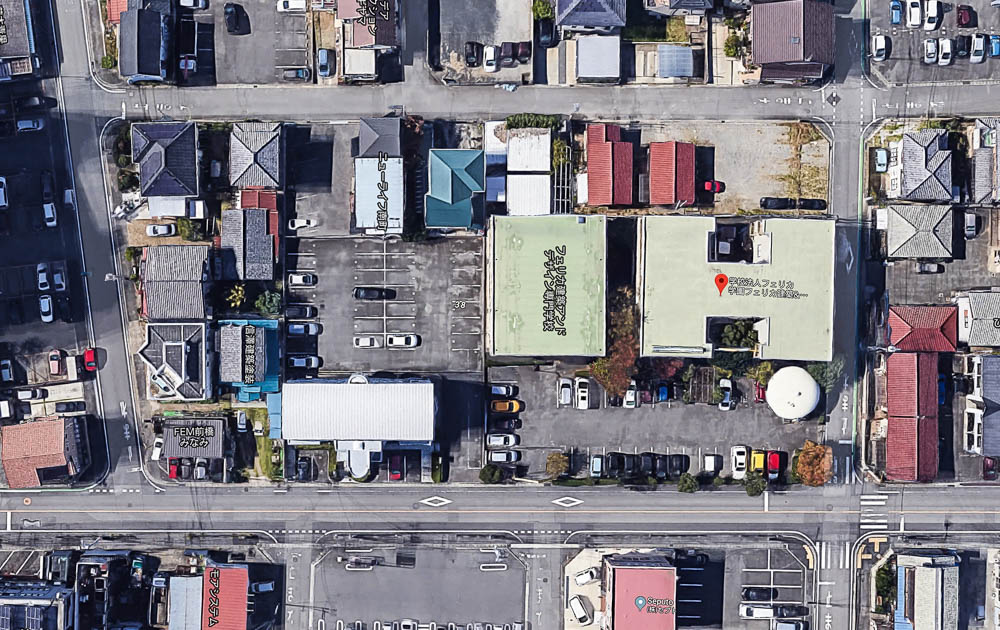
The other Futuro – now that was a real mystery. Everyone had it pegged as lost or destroyed. After all, many of these unique little structures have succumbed to that exact fate, and there are only around seventy or so left in the world today. It’s notoriously difficult to keep track of these things! Just ask Simon Robson.
The owner of a niche little website called ‘The Futuro House‘, Simon has devoted an incredible amount of time to creating the world’s best online resource on Futuro. He details every known fact about these odd little houses and meticulously maintains the website as on ongoing labour of love. Late 2017, he receives new information about our missing house in Japan:
“The current locations of the these two Futuros has to date been unclear. … That all changed this week when James Cashmore sent me an email following a visit … “[the Futuro] needs rescuing, but it’s almost intractable from behind a property deep into trees … It’s a shame that it’s not being taken good care of but at least it’s dry and hidden from too many peeping eyes!”
And just like that, the missing Futuro was back on the map, quite literally, with an updated aerial image on Simon’s site showing what could indeed be the tip of a haikyo Futuro peeking out from under a swath of trees. Naturally of course, there was no address or solid information. I’d need to test my research skills to unearth this place…
Let’s Sleuth!
Armed with Simon’s image, I first tried searching a rough area via Google Maps, but with such a vast amount of ground to cover, my enthusiasm to find the Futuro quickly died. And so it sat in the back of my mind, nagging me for a couple of months, until I decided to try another approach.
What other information was available that might help me with my search?
Simon’s website had mentioned some old issues of a Japanese design magazine – Casa Brutus – which talked about a Futuro listed for sale. He wasn’t unable to decipher them due to not understanding Japanese, but that wouldn’t be a problem for me, and maybe that was how our mysterious friend James had also put all the pieces together! Perhaps the magazines even gave the exact address!?
So I begin looking around on the internet for old issues of the magazine. It wasn’t easy – over fifteen years have passed since those publications, but I manage to dig up a few issues on various auction websites. The prices weren’t high, but I didn’t want to wait a week for delivery… Then I had a stroke of common sense. It seldom happens these days, but thankfully the ability hasn’t deserted me entirely!
Don’t libraries stock old issues of books and magazines?
Duh. The internet has spoiled me.
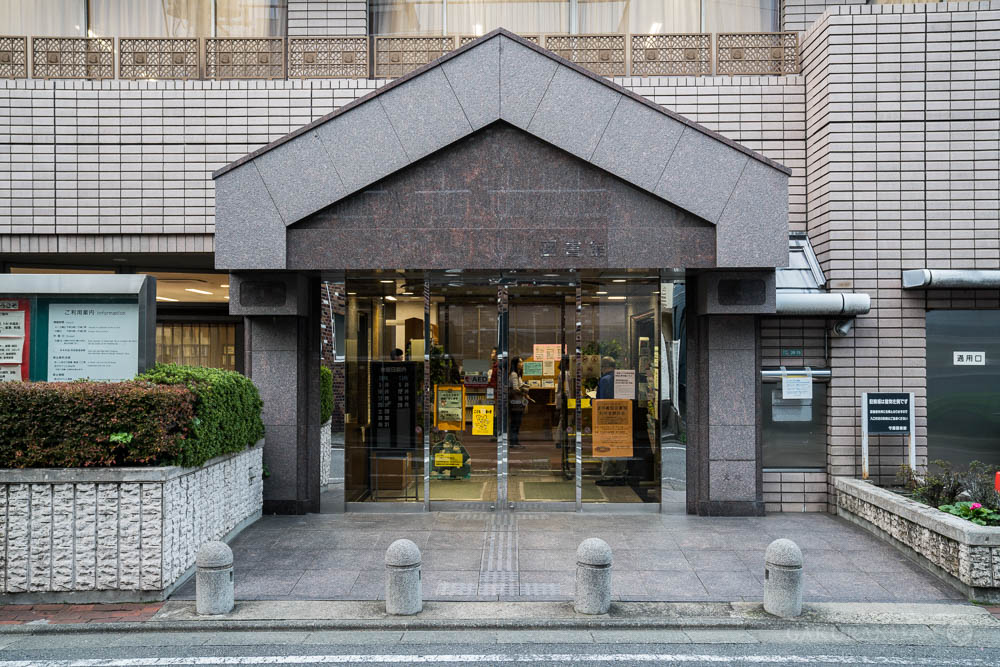
Jumping on the Tokyo Metropolitan Library website, I unearth a list of local institutions that have my magazine. Not many, it seems! Only two libraries claim to have a complete collection to browse, so I make a stop late Saturday afternoon and begin to read…
On the Trail of Lost Icons
It all began back in summer 1999, when the Casa Brutus editorial team published their seasonal issue with a special featuring Nordic design. Included in it was our object of interest, the Futuro house.
Fast forward to the beginning of 2001. They receive sudden contact from their Northern European office, which I can only assume was by pager or something due to the way it’s described in the magazine. Either that or someone loves old spy movies!
“Futuro. Captured. Requesting. Immediate. Contact.”
The editorial team shoot over to Finland to attend a coveted one hour meeting with the late Futuro Father himself, the original architect Matti Suuronen. Here we find a goldmine of information about the Futuro’s conception, and the tantalising mention that two of the houses were imported into Japan! Evidently the Casa Brutus team didn’t know this at the time. I’ve taken the liberty of translating the interview from the April 2001 issue:
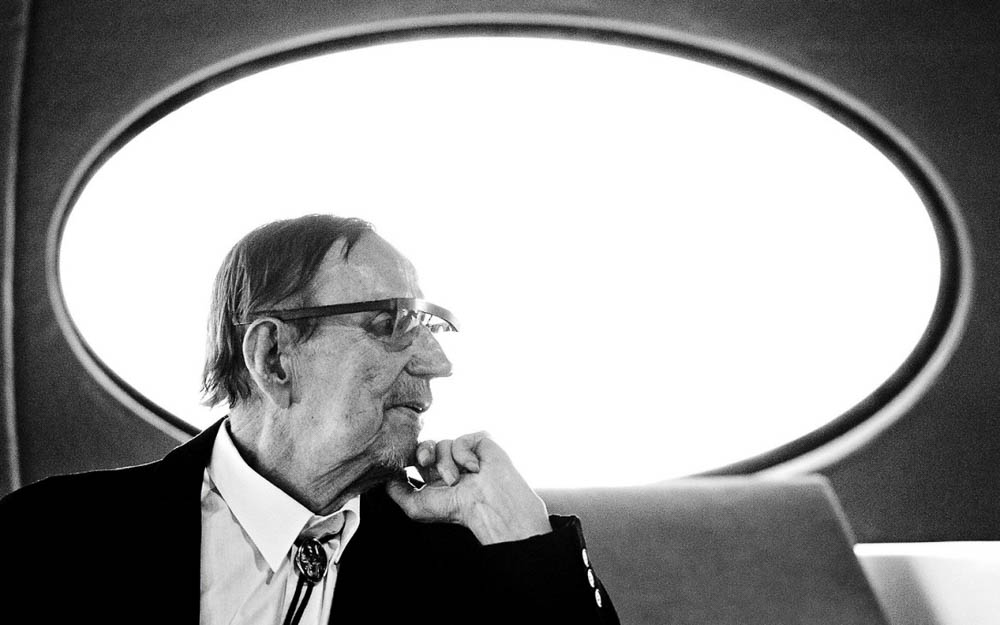
CB: “Why did you originally decide to build a disk-shaped house out of plastic?”
Matti: “My friend said he wanted to build a small hut on a ski slope you see. But it was in a place with a steep slope and no roads leading to it. So I wondered to myself if I could build a lightweight house that could be transported by helicopter.”
CB: “But why a circle?”
Matti: “Regular squares don’t exist in the natural world. The Futuro is in the shape of a natural rock or mushroom. That was the reason I decided to make it disk-shaped.”
CB: “How many Futuro were actually produced?”
Matti: “About forty or so were produced. If I recall I think two of those were exported to Japan.”
CB: “What! You mean there are Futuro in Japan!?”
Matti: “Yes, I’m sure one was bought as a holiday home. A Japanese trading company bought the licensing rights and was set to start selling them. In order to acquire the building rights, we dispatched an engineer. According to tests by the Yokohama National University, they identified that the Futuro could withstand earthquakes and typhoons, and was suitable for use in disaster areas”.
CB: “That’s very surprising.”
Matti: “I don’t know if that one is still in Japan right now, but eighteen Futuro have been confirmed as still existing in the world at this point.”
CB: “Where are they?”
Matti: “According to the film director Mika Taanila and researcher Marko Home, there are two in Finland, one in Estonia, one in Holland, two in Australia and twelve in New Zealand. The one in Holland is the prototype I made and it is apparently currently sleeping in a warehouse of the Utrecht Art Museum.”
A Wooded Launchpad Under the Stars
It’s now late spring 2001 and the Casa Brutus editorial team are heading towards a secluded forested area (probably along much the same route as I’m driving today). Things are just starting to warm up in Japan, much like their budding Futuro story.
Accompanying them is one Sadao Watanabe. The team has managed to connect with him after receiving an unexpected tip-off from a reader following their April publication…
Mr. Watanabe definitely recalls a Futuro left sleeping in the woods. After all, he was the one who decided it should stay there! But that was several decades ago. It’s anybody’s guess if it’s still there, if he can even remember the exact location. His memory isn’t exactly what it used to be. But the editorial team are budding explorers after my own heart, and they waste no time in snatching up the challenge.
Paralleled in spirit with the Casa Brutus team from seventeen years ago then, I find myself driving around those same rolling wooded roads, winding up and down hills, criss-crossing in a meandering search for a lost icon of the design world. A few choice clues from my research in the magazines have enabled me to narrow down my search, and a pin now rests promisingly on my map, in what I hope to be the right spot.
A smorgasbord of colour greets my eyes and sunlight glitters invitingly through the changing leaves. It’s a quiet Sunday morning in Autumn and I’m eager to stretch my legs after the three-hour drive. The pin on my car navigation comes into view.
Three minutes now. The moment of truth…
I’ll know very soon if my research has all been in vain or not…
My heart is pounding. Turn right here. Straight on. Left and then left again. It should been just around here on the lef…
Holy crap there it is!!!Fuck yes!Yeah!!!
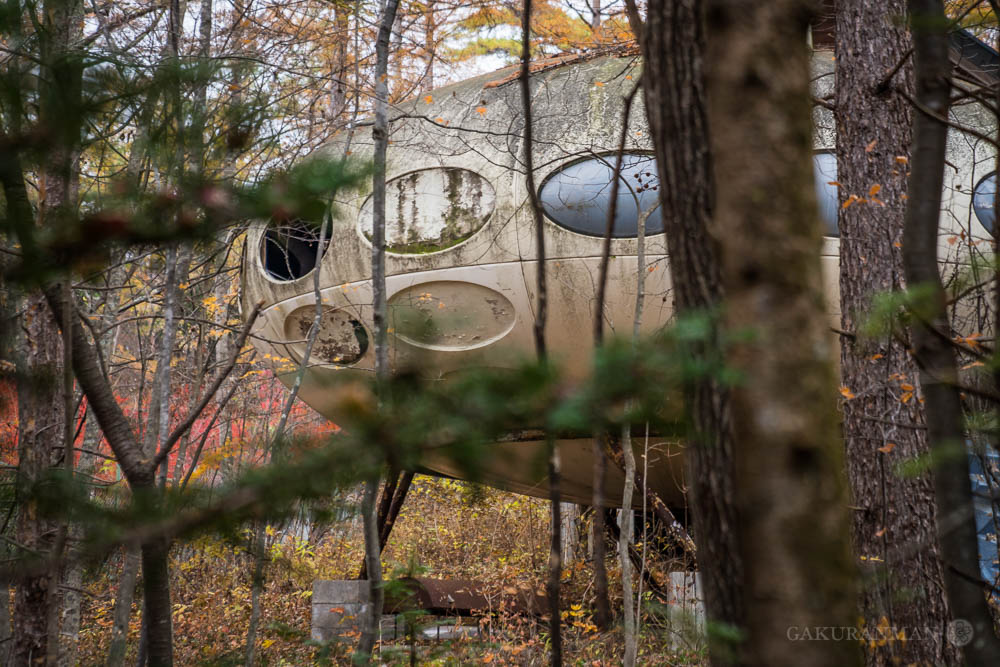
I catch a glimpse of the mysterious little house tucked away between the trees and other properties dotting the landscape. It’s a blink-and-you’ll-miss-it situation. Very well hidden, but there stood our alien lodging! A landmark of 70’s design slumbering forgotten amongst the trees.
Hell yes!!!
Parking up and approaching with care, I snake between trees, all the while very conscious of the conspicuous crunching of dry, fallen leaves underfoot.
The last thing I want is to be detected before I can snap a few pictures…
Clambering up a couple of slopes, I make my way forward and gaze in awe. A UFO-like structure looms before me, spider-like eyes bulging from its globular trunk, seemingly scanning the vicinity for threats.
No alarms. We’re safe, for now…

The Demolition Man
The editorial team arrived at the dilapidated old Futuro with smashed windows in much the same way as I did. After an hour of nail-biting trial and error, Mr. Watanabe delivered the goods! It was featured as a double-page spread in the July 2001 issue of Casa Brutus:
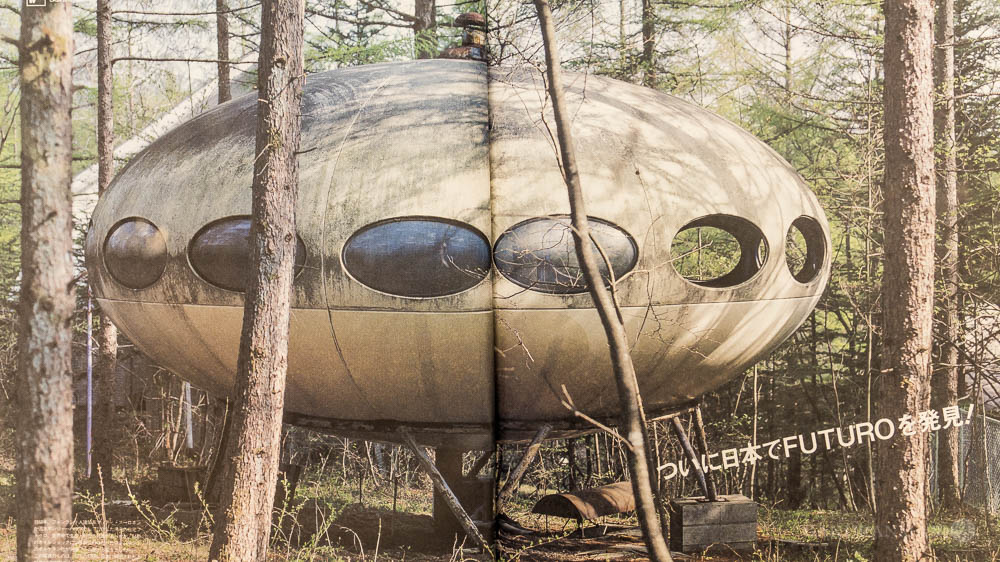
For the editorial team however, this was actually the second Futuro they’d seen that day. You see, Mr. Watanabe was the proud owner of his own Futuro house!
In one day the team had tracked down both of the lost UFOs mentioned by Matti during their interview. The reader who had written into the magazine was evidently the son or daughter of Mr. Watanabe:
“My Dad actually owns owns a Futuro house…” says the correspondent.
Finally! Someone who actually imported one? And so close to home! We didn’t even get to see an actual Futuro even on our trip to Finland… the team writes.
After liaising with the reader, the team travelled to meet up with Mr. Watanabe. He took the team to see his Futuro, perched one thousand meters up a mountainside forest, located on a storage site for construction materials. They recall their first sighting of the iconic UFO house:
We travel up a well-paved, wide mountain road by car for fifteen minutes. Suddenly, an object radiating a dull, white light appears before us.
So… Big…
We’ve even has dreams about this Futuro, and now we can finally photograph it for ourselves!
It’s a lot cooler up in the mountains, and the relaxed greenery is a welcome break from the bustling city. Mr. Watanabe grins as the team snaps away at the rarity he owns. Sitting there four meters high by eight meters wide, is indeed a real Futuro house. Originally Mr. Watanabe’s personal karaoke box, it was unused now for three years. Slightly weathered and dirty, but very much an intact original in all its glory!

The team is in awe as they step inside the small, robust plastic dwelling. Fully furnished, it looks just as it did when first produced some thirty years earlier. A retro time-capsule, which in this sense is entirely appropriate due to its contained, rounded shape!
As the team admires Mr. Watanabe’s prized house, he regales them with the story of how he became the owner.
This is where things really get interesting. I’m pretty sure this is the first time the following information has been published in English on the internet. Paraphrasing from his interview:
CB: “So you’re not the original person who imported this Futuro, right?”
Watanabe: “That’s right. I was tasked by another company with demolishing it.” he begins.
“There were actually two disk-shaped buildings at that time, but the one further back was blocked by trees and couldn’t be destroyed.”
CB: “What state were the Futuro in when you were asked to demolish them?”
Watanabe: “You know it looked like it had become a couple’s [love] nest, being left unguarded like that. It seemed like young people had broken the window at night and were going inside.”
CB: “How did you move such a big object?”
Watanabe: “One piece was around three meters so it wouldn’t fit on a truck. I used a couple of two-tonne trucks and a large trailer to move it. Because it was made of plastic we were able to move it with about two people.
CB: “What about the assembly?”
Watanabe: “I put it together in my free time between work. There was an incredible amount of screws and no plans to refer to, so I had to rely on my instinct. Sometimes the parts wouldn’t fit and I had to use a saw.”
CB: “It’s pretty dirty isn’t it?”
Watanabe: “At first the surface was actually really smooth and shiny. When Mt. Asama erupted (a hydrovolcanic explosion) in the nineties, a lot of particles invisible to the eye flew over and stuck to it. After that it started to get dirty.”
CB: “What about the other Futuro?”
Watanabe: “It was several decades ago… I don’t know if it’s in the same place now or not…”
And so it went. The editorial team drafted Mr. Watanabe to take them to the second, ruined Futuro that same day! Now it had been re-discovered, what was the team to do?
We’ll get to that shortly. But first, let’s go inside our haikyo UFO house! I’m dying to take a look!
(Interesting sidenote for Japanese readers: ‘Couple’s [love] nest’ was アベックの巣 – a now defunct term originating from the French ‘avec’ to ‘be together with’. A boyfriend or girlfriend was referred to as ‘the person [I’m] with’. So ‘couple’s/lover’s nest’).
A Portable Playhouse
The door to the shuttle is already open, and a sprawling blue tongue welcomes my arrival. A series of ovals sit cheek-to-cheek around the fattest point of the ovoid fibreglass frame. But don’t spend too much time staring – you’ll see an alien face laughing in derision that can’t be un-seen.
Whoops.

Climbing up the stairs we find ourselves inside a quaint entrance space. In front of us is the oviform portal to the main chamber, attractively framed by more ovals. You’re noticing a theme, I see. Evidently these were hidey-holes for keys and other nick-nacks. To the left, the bathroom door. Equally ovate. How many words can I find to describe ‘egg-shaped’, I wonder..? Look closely and you’ll see the metal cord attached to a winch that once opened and lowered the spaceship door. No, that’s a circle.
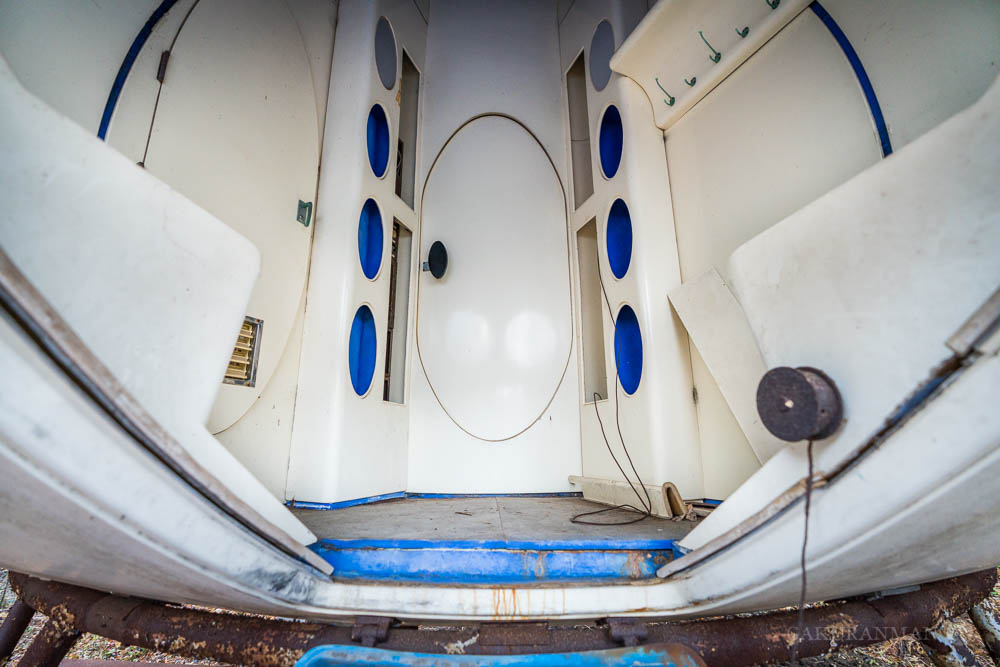
Pushing open the glossy, white door we step back in time. It’s surprisingly… elliptical! Spacious too, a least above my head. The floor only measures about 25 metres square. Still, more than my first Tokyo apartment!
Light pours in from the windows spaced equally around the room. Some hold grimy perspex panes, while others have been smashed and allow the fresh, Autumn air to flow in and out. A few have rotting boards covering them – signs of an attempt to keep the woodland out. Holes in the wooden floorboards show neglect.
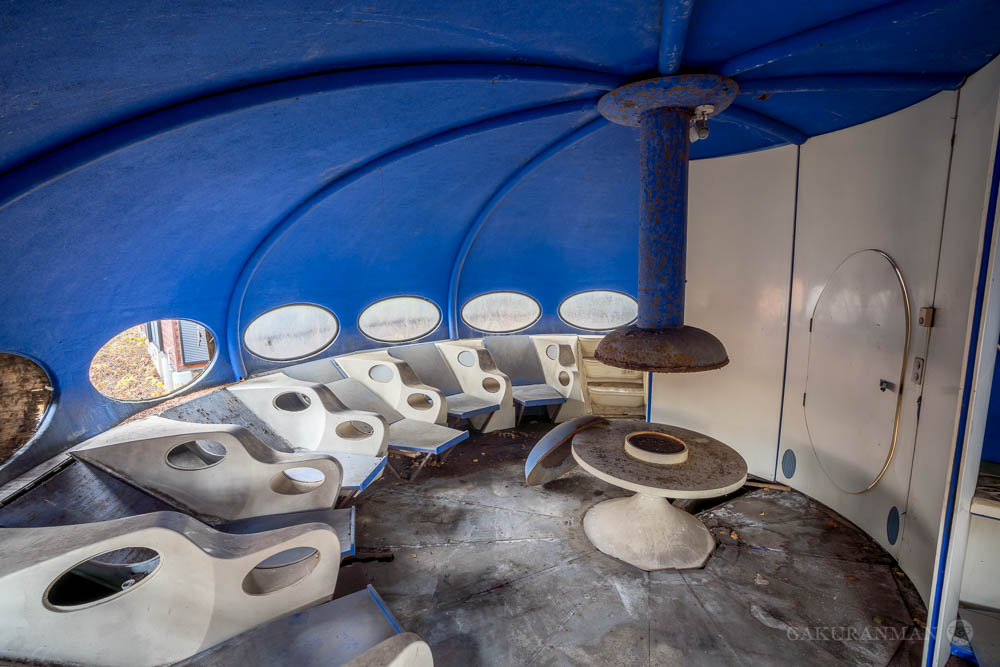
In the centre stands what looks to be a table, but on closer inspection is actually a fireplace. A large extractor funnel extends up to the roof and a hood sits resting on the floor. You’ll surely notice as well that everything is very blue. But this is only the barebones fibreglass base of the house. Imagine it with rich, red carpets and mood lighting in the seat dividers. Throw in a sexy lady with a cute seventies miniskirt and you have yourself a snug little living space.
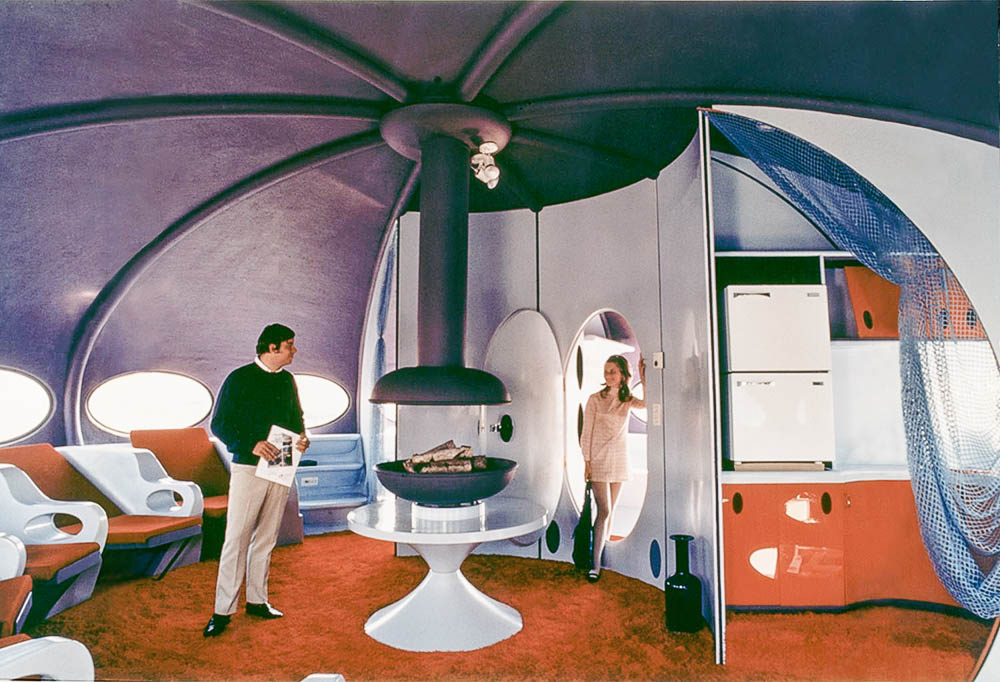
Where’s the boudoir? Glad you asked. It’s just behind the fireplace, obviously where the gentleman in the above photo is picturing himself next.
No really, just look at the brochure he’s holding. Every Futuro comes equipped with six reclining chairs for lady friends to lounge around seductively and a private bedroom with drapes, Just For Her.
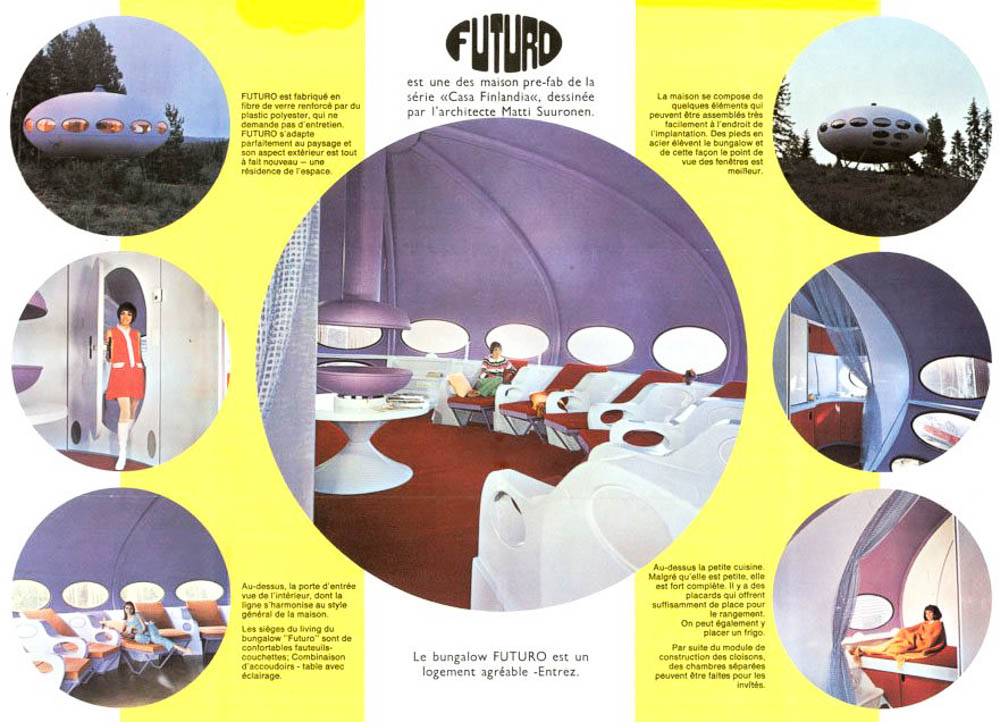
I’m glad our gentlemen hasn’t seen the sorry state of this bedroom though. Not a whole load of space there. You’d almost be sleeping on top of one-another… That might not be a bad thing, if it weren’t for wafter-thin mattress and punctured cushion which looks to be a breeding ground for something creepy and crawly.

But it does seem as though the interior was infinitely customisable. Here is a blue-meanie version of the Futuro house in Berlin, with what looks to be an extended bedroom which is all bed (good choice!) and a study! And look, no fireplace!
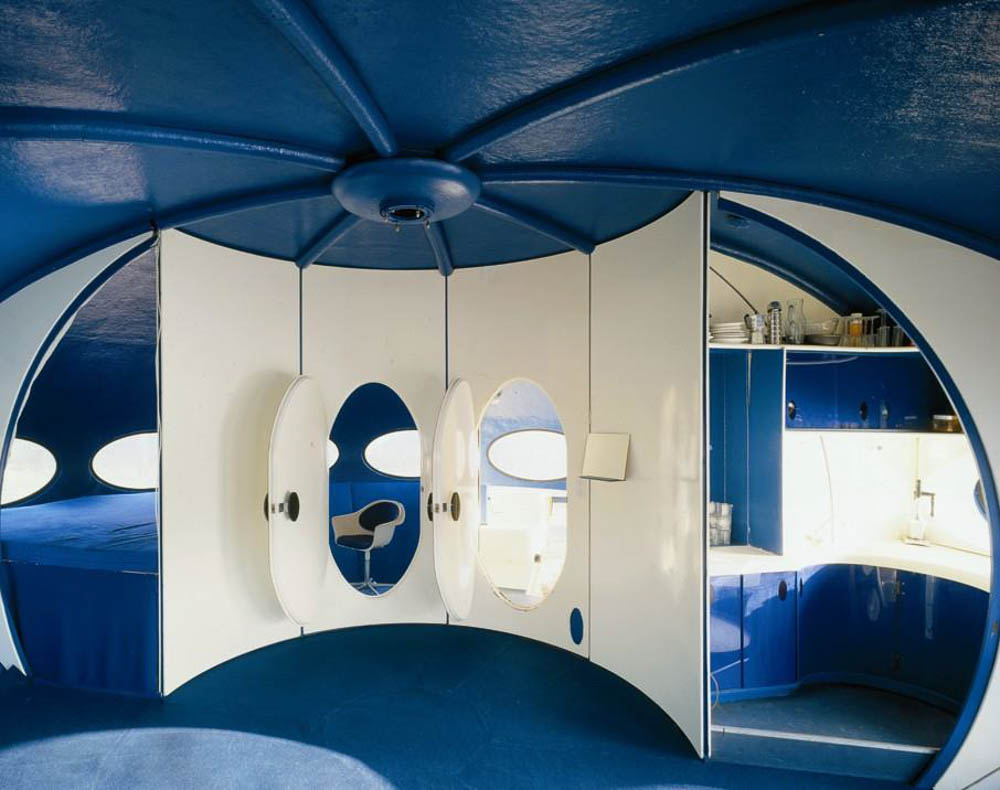
Yes, yes. That area to the right is indeed the kitchen. In our Futuro it has become a mere storage space for the missing window panels and dividers. A lonely tap is the only reminder of its true purpose.
The other room below is the one we passed on the way in – a combined bathroom and toilet. The shower is above my head in this picture, and behind me a sink and window. For creature comforts you have your very own squid-inspired water heater! I have to say though, the lime-green coloured toilet doesn’t make me happy. At all.
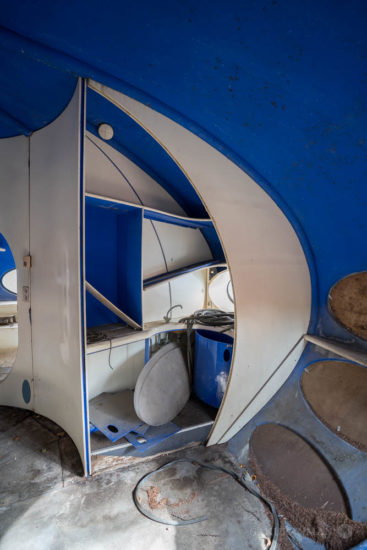
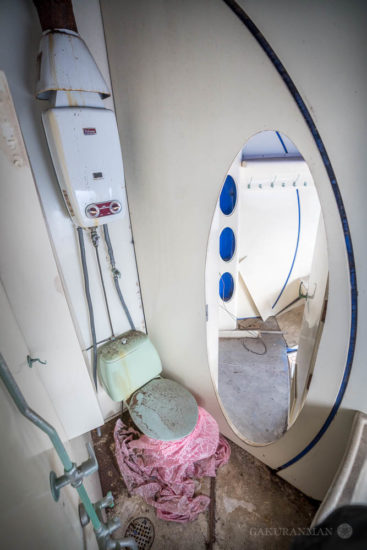
Although this is a gas water heater, the Futuro itself featured an innovative heating system. Polyurethane insulation combined with electric heating that apparently warmed the place up from -28° to 15° Celsius in only 30 minutes. That’s pretty important if you’re halfway up a snowy mountain – the original concept for the Futuro was as a ski chalet after all!

The final area is the space next to the kitchen. This section sports an additional four windows for fire safety that round off the Futuro’s distinctive design. These are situated much lower to the ground than the main ring of windows around the edge. I imagine the horny couples that Mr. Watanabe mentioned from many years ago may have broken in through one of these bottom windows for their secret spaceship trysts.
It’s not obvious to me though what used to sit in this space, and a similar photo from the Berlin Futuro doesn’t help much either…
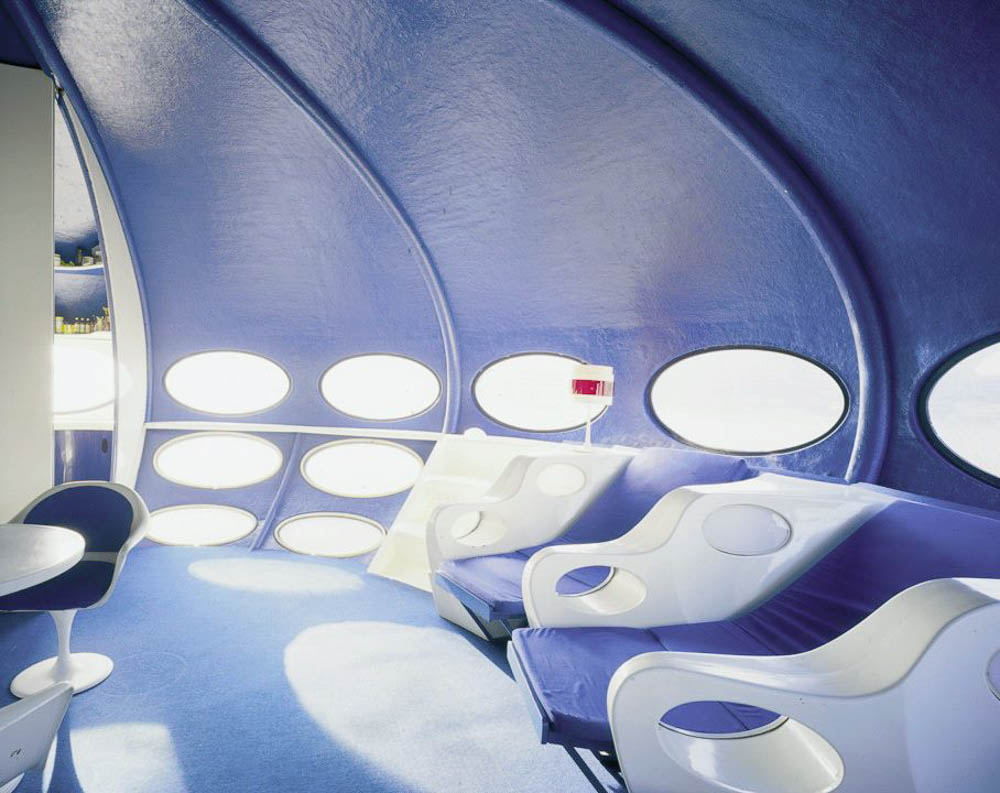
However, the original Futuro floor plans give us some clarity! You can already see that the design of our haikyo Futuro differs from the above plans slightly in the layout of the doors, reflecting the customisability. But the low viewing windows sit neatly behind what is labelled as the dining area. That makes sense – the rest of the unit is full of reclining chairs, so there needs to be somewhere with a table! And bar storage. I knew something was missing from this idyllic bachelor-pad.
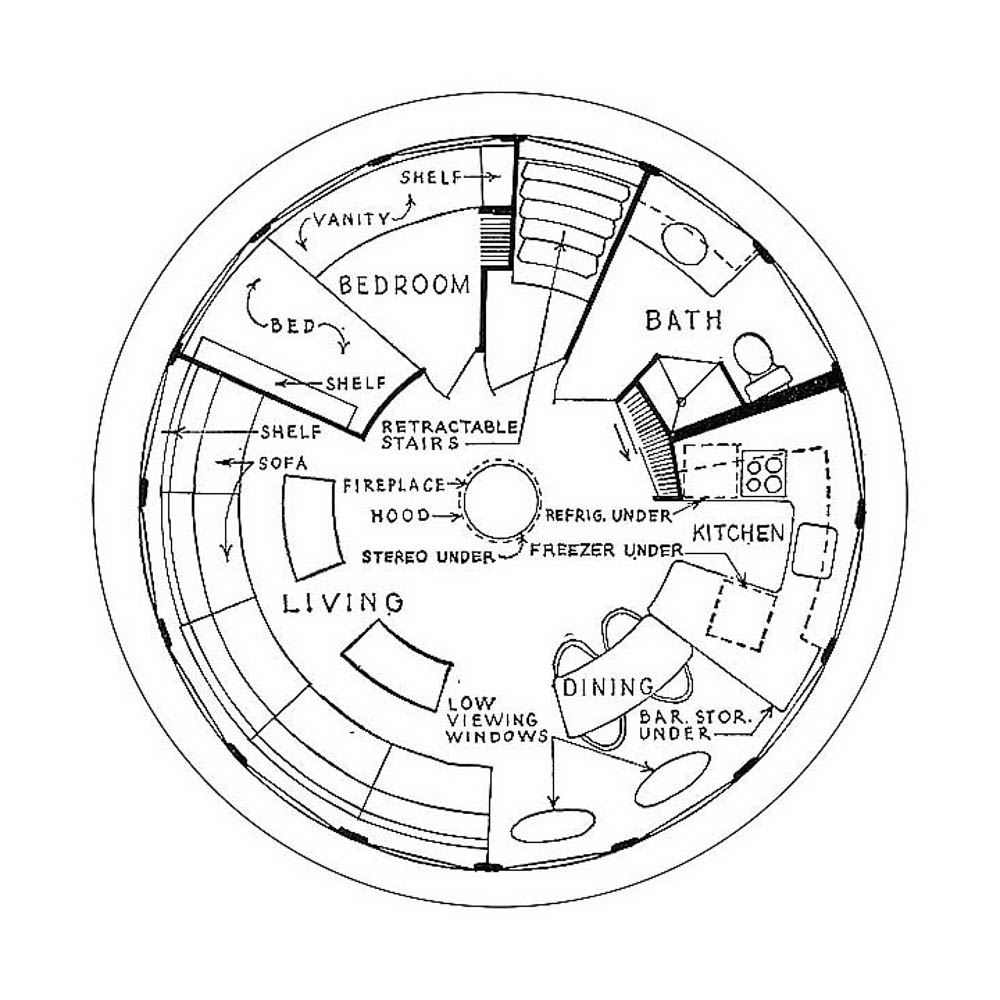
Finally, here’s a view of those reclining seats from between the fireplace. You can see just how rusty the funnel has become! Notice the dividers between the seats and their distinctive triceratops design.
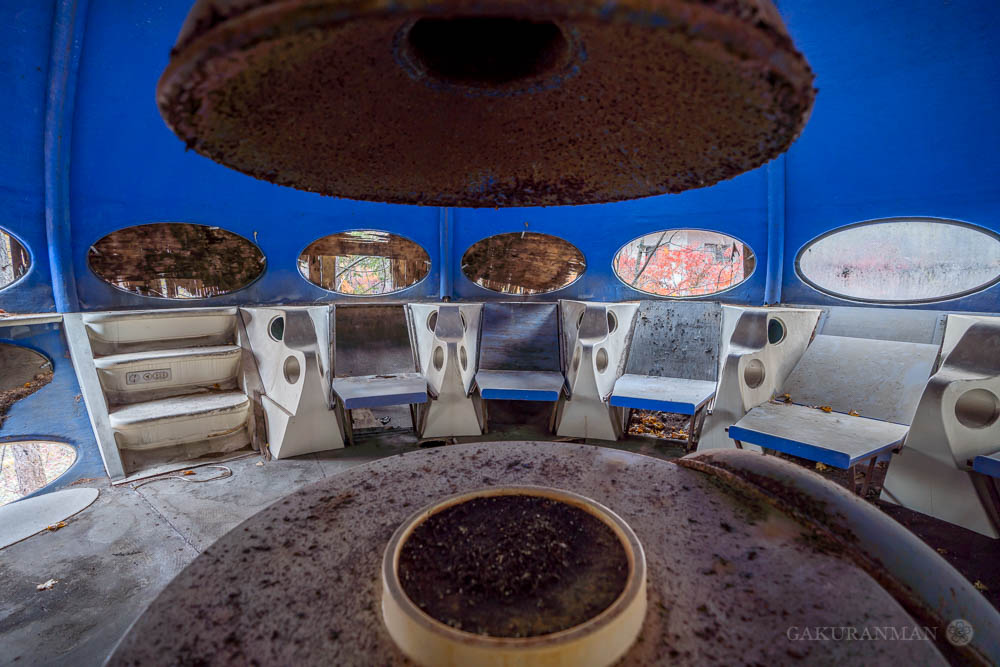
These panels actually contained internal lights as you can see in a refurbished Futuro photo below. It actually looks quite regal when clean and garnished with cushions and carpet!
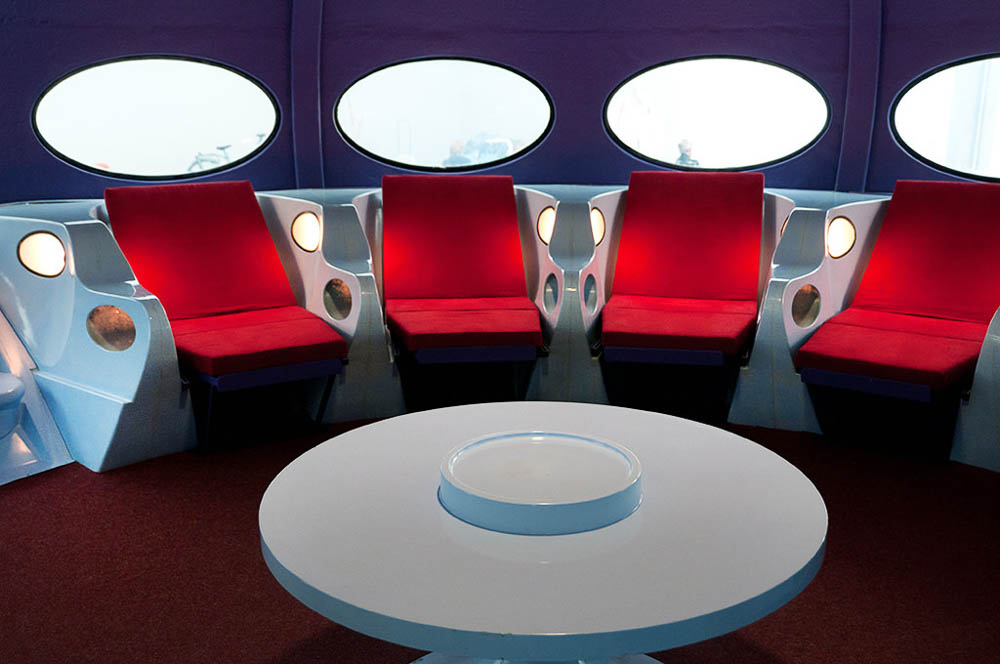
Maybe I should consider hunting down the landowner and buying up the property. It’s well past its minimum thirty year lifespan now, but perhaps still salvageable…
That’s essentially what our friends at Casa Brutus were planning to do.
Looking For a Place to Land
At the end of their July 2001 issue after discovering the run-down abode, the editorial team leaves some interesting comments.
We just couldn’t bear to see a Futuro left in such a sorry state. So the Casa editorial team is planning to restore this historical experimental home it to its former glory. If we’re successful, a Futuro might visit Tokyo this Autumn. Will it be restored!? Watch this space to find out!!
And so it went.
Roll on to October 2001, and sure enough a Futuro is listed for sale: “Looking for a place to land” – yours for 5,000,000 JPY, tax inclusive (about 41,500 USD) + costs to transport the home. That’s about 7,500,000 JPY or 62,000 USD today. So was this our ruined Futuro? Did the editorial team manage to restore it for sale? Was the shiny, white Futuro now stationed outside the Felica Academy in Maebashi actually the one from the woods?
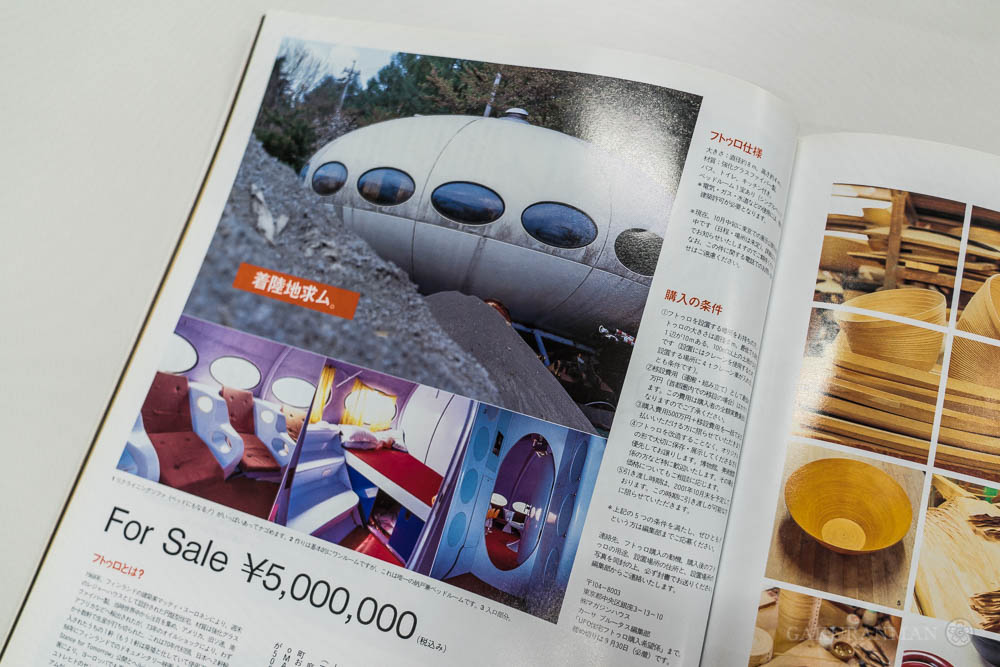
Those were the questions that had remained unanswered on Simon’s website until late 2017. After all, anyone just looking at the pictures in Casa Brutus wouldn’t have been able to tell that two Futuro had been found by the editorial team. A dilapidated home had been discovered, and in a later issue one was listed for sale. So obviously they must have refurbished it, right?
So when the haikyo Futuro was again re-discovered by James Cashmore, it became clear that the abandoned Futuro still lived among the woodland creatures. Translating the text in the October issue also confirms this was the case. Tucked away somewhere down the bottom of the listing is a sad little note explaining that the “other Futuro was in a ruined state and not able to be used”.
So the grand plans of the Casa Brutus editorial team had died with a whimper. The Futuro listed for sale was Mr. Watanabe’s very own!
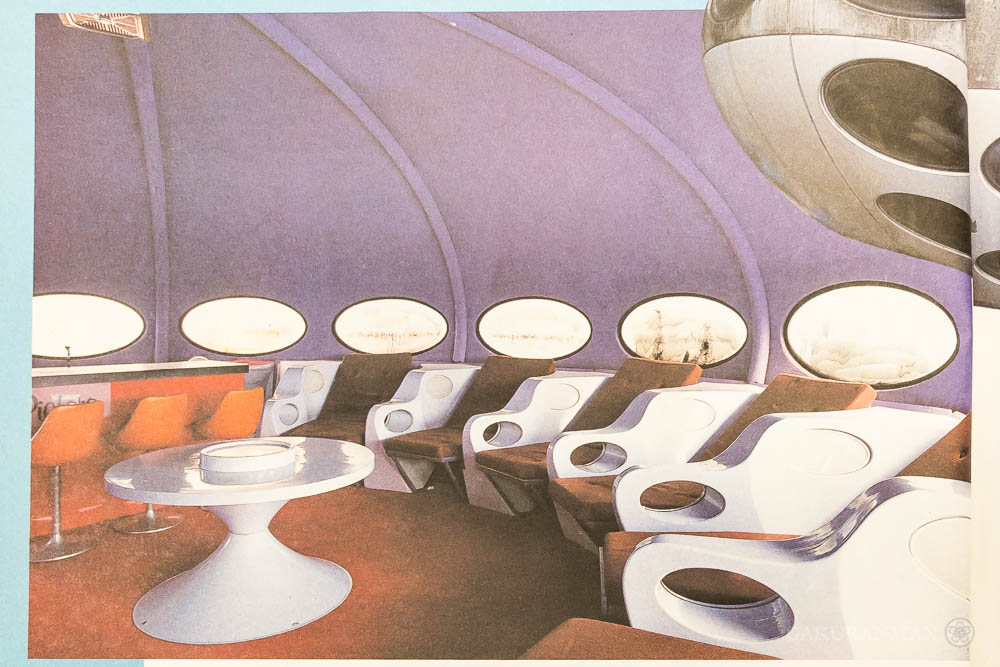
Alien Sighting in Tokyo
In the one-year of anniversary issue of Casa Brutus (the November 2001 issue), we again see the ‘for sale’ listing on the Futuro and learn that the editorial team will be transporting it to the Tokyo Designer’s Week on 11th-14th October. I guess it hadn’t sold since the previous issue’s listing and the team had negotiated to bring it to Tokyo as part of the annual event. It’s apparent that the Futuro will be exhibited to the public, in addition to continuing the search for a new owner!
Attendees can also get an original Casa tote bag sporting a Futuro design by buying back issues of Casa Brutus at the event! Alas, I scoured Yahoo Auctions, but couldn’t find one…
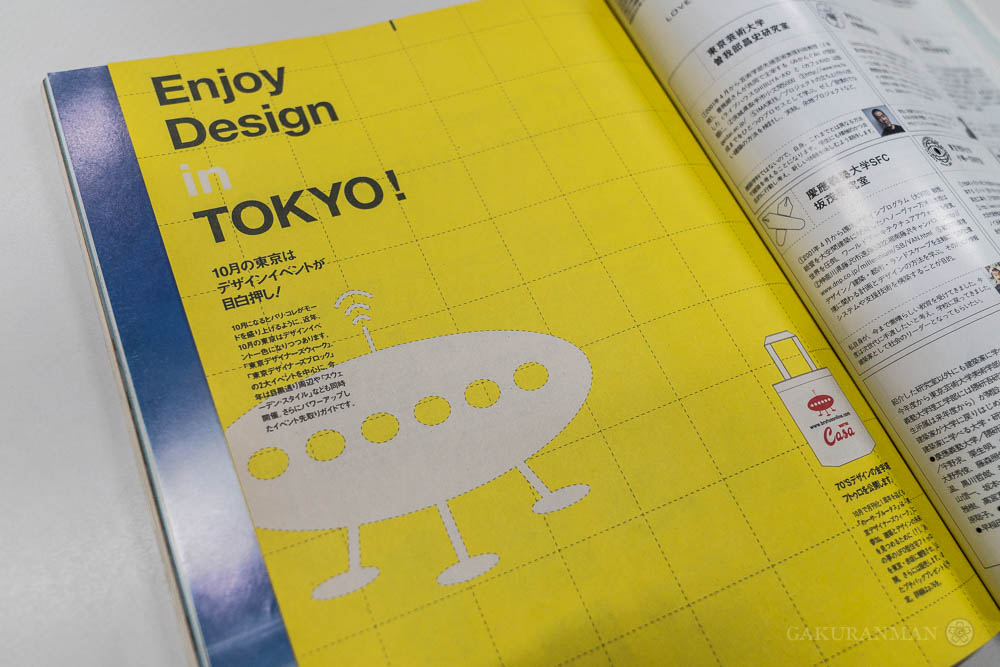
Finally, in the following December 2001 issue, we see the outcome of Tokyo Designer’s Week. There’s a special space-age fashion feature in the magazine showing luxury designer clothing, with accompanying brand names, prices and phone numbers for purchase. My guess is this what partially funded transporting the Futuro to Tokyo.
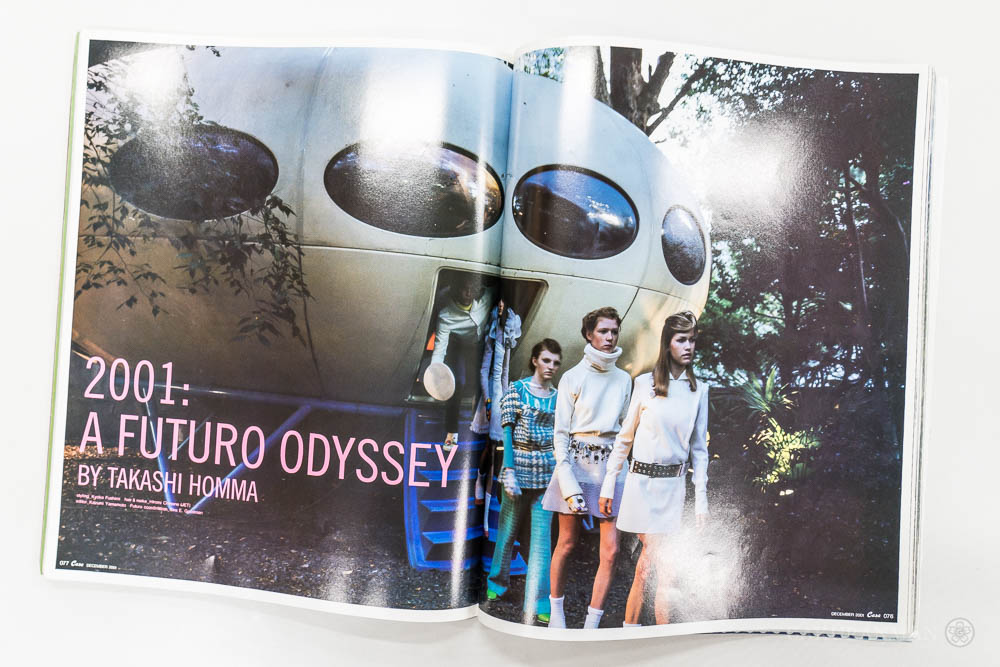
In addition, a photo of a sparkling clean Futuro taken in Akasaka. Visitors were apparently greeted by a gleaming grey alien and invited to look inside, even sampling the luxurious day beds equipped inside Mr. Watanabe’s Futuro. The lines stretched with waits of up to forty minutes! Tantalisingly, the editorial team ends this magazine saying that they will reveal the new landing location of the Futuro in a future issue – I guess they found a buyer!
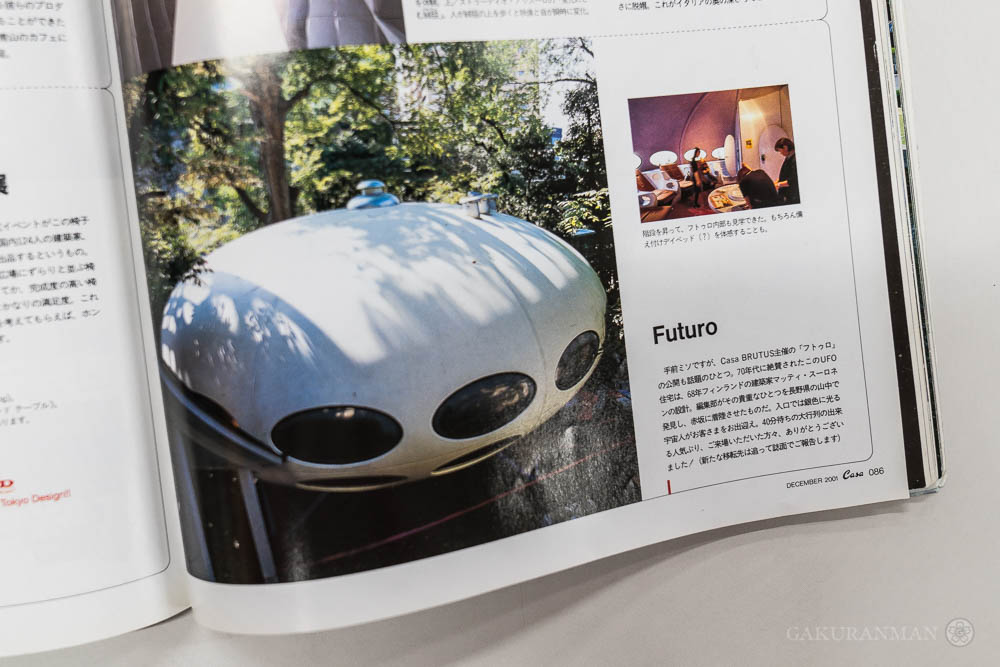
I attempted to find the future issue which recorded the next location but wasn’t able to do so. Unless something very strange happened in-between then, we can only suppose that new location to be none other than the Felica Architecture and Design Academy in Gunma! This explanation is supported in the definitive work, ‘Futuro: Tomorrow’s House from Yesterday’ by Marko Home (long out of print and extremely hard and expensive to find). Thanks to Simon for the references:
In 2001, one of them was purchased, restored and placed on display in Tokyo by the editors of the Japanese design magazine Casa Brutus. It has since been entrusted to the Felica Design School in Maebashi.
I reached out to James Cashmore too, for a bit of background on his discovery. In his own words:
Hi Michael, we have friends who have a house nearby. They always mentioned that there was a UFO building in someone’s back garden so naturally I was inquisitive. I knew a little bit about Futuro buildings and after Googling it realised it was quite rare. Since it’s not owned by anyone we know I didn’t want to make it public. That’s pretty much the story. Hope it helps.
That about wraps up all the loose ends.
Or does it..?
The Mysterious Importer
Once garnering the attention of the world’s media, Futuro represent an incredible piece of human architectural history, engineering prowess and design aesthetic. The first prototype was manufactured on 1st April 1968, so by happy serendipity the year of my visit – 2018 – also marked the fiftieth anniversary of its conception. But Futuro houses were also controversial, and production was quickly halted.
Why did they stop producing them? What did people think of it? And who imported them into Japan?
For these questions, who better to answer than Simon.
The Futuro House ran into several problems that ultimately led to its failure to generate widespread acceptance or large scale orders and manufacturing. The primary reason was the 1973 Oil Crisis which saw the cost of oil, and thus of the primary raw material used in the manufacture of Futuro’s, triple almost overnight.
That said there were other factors one of which was a struggle to gain acceptance from administrative authorities, in particular planning authorities and building regulators. Often times the planners did not think Futuro matched their vision and the building regulators simply could not figure out Futuro and how to regulate it.
But how did the two Japan Futuro come to be where they are? Details are sketchy.
According to Simon’s website, at least one of the them was originally based in Yokohama. Then at some point afterwards it seems both of them were moved to the countryside. In the book ‘Futuro: Tomorrow’s House from Yesterday’ by Marko Home, we can see a Shinto groundbreaking ceremony taking place at the very site the now decrepit Futuro was constructed.
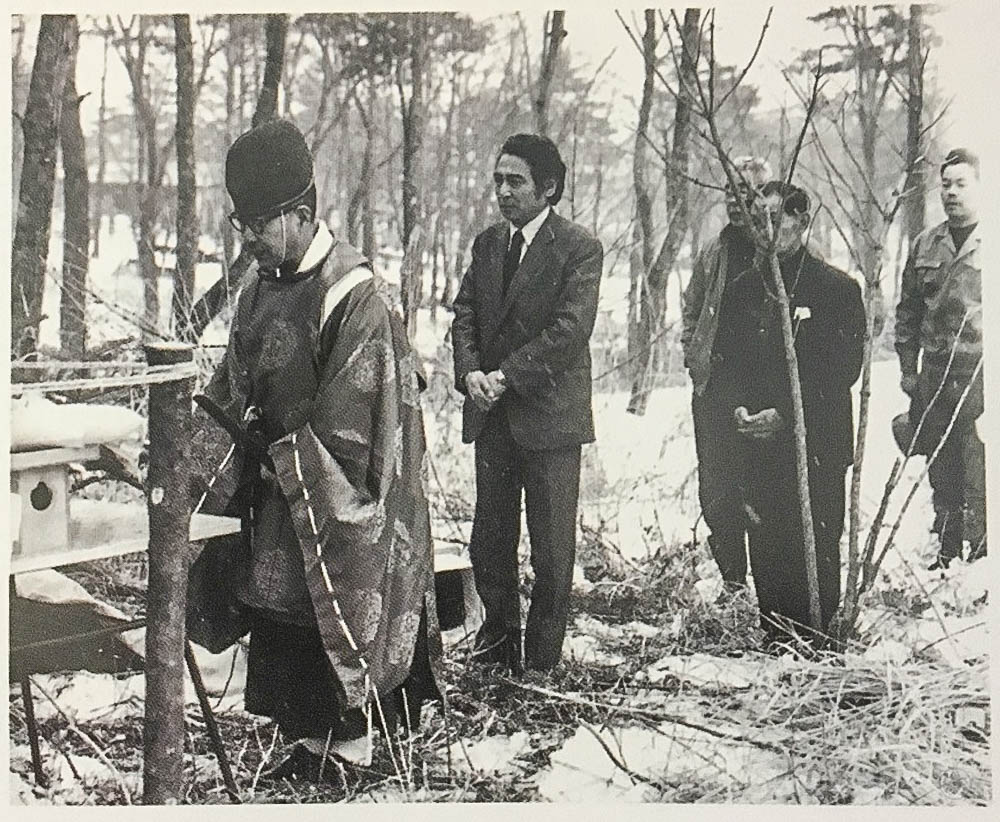
These purification ceremonies are common in Japan even today before building new homes. They are undertaken to appease any spirits lurking on the site, aiming to ensure the smooth and safe completion of the project. They are more social than religious though, and done as a matter-of-fact than due to overt superstition.
There’s some fascinating footage showing this particular ceremony on the film ‘Futuro – A New Stance For Tomorrow’ by Mika Taanila.
You’ll have also noticed in the video some scenes showing the original construction of our haikyo Futuro. We can see a younger version of the telltale tree standing in front of the home in this footage. It looks as though nobody really considered it might be moved in the future, and it’s these very trees that saved it from demolition at the hands of Mr. Watanabe years ago!
Perhaps the spirits were watching over it.
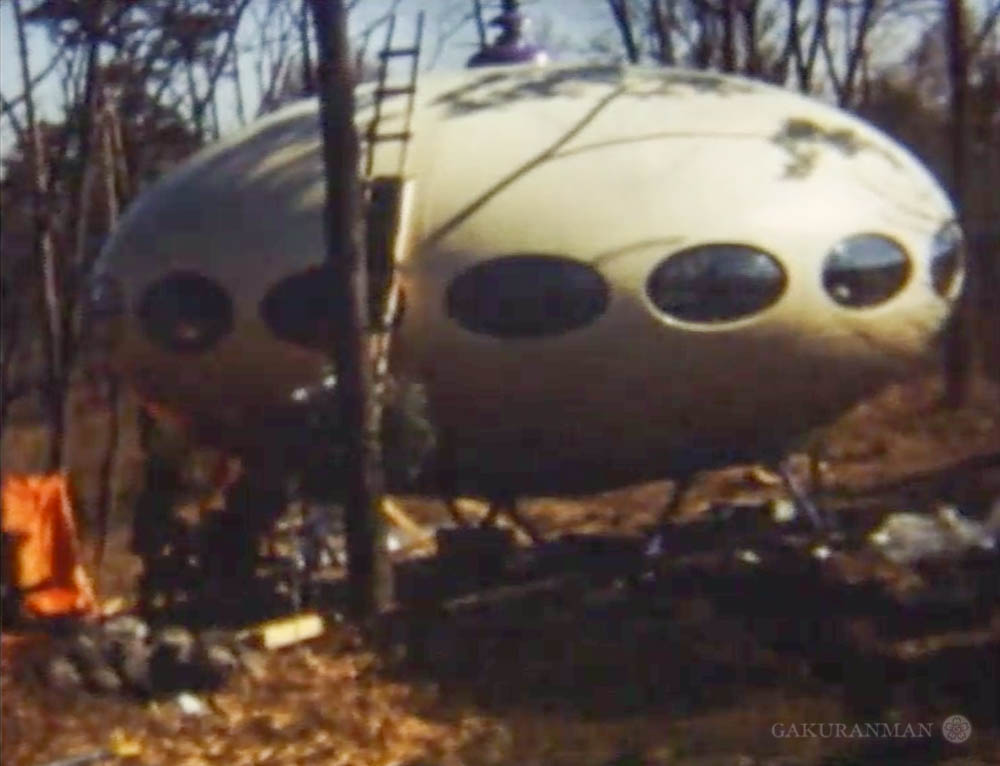
Going back even further, we find that the two Futuro were originally imported by one ‘Matsouka Shoji’ to Japan in 1972, according to Matti Suuronen’s ‘Futuro CV’. They are listed as part of the original ‘Finnish 20’ – the first batch of Futuro houses ever produced.
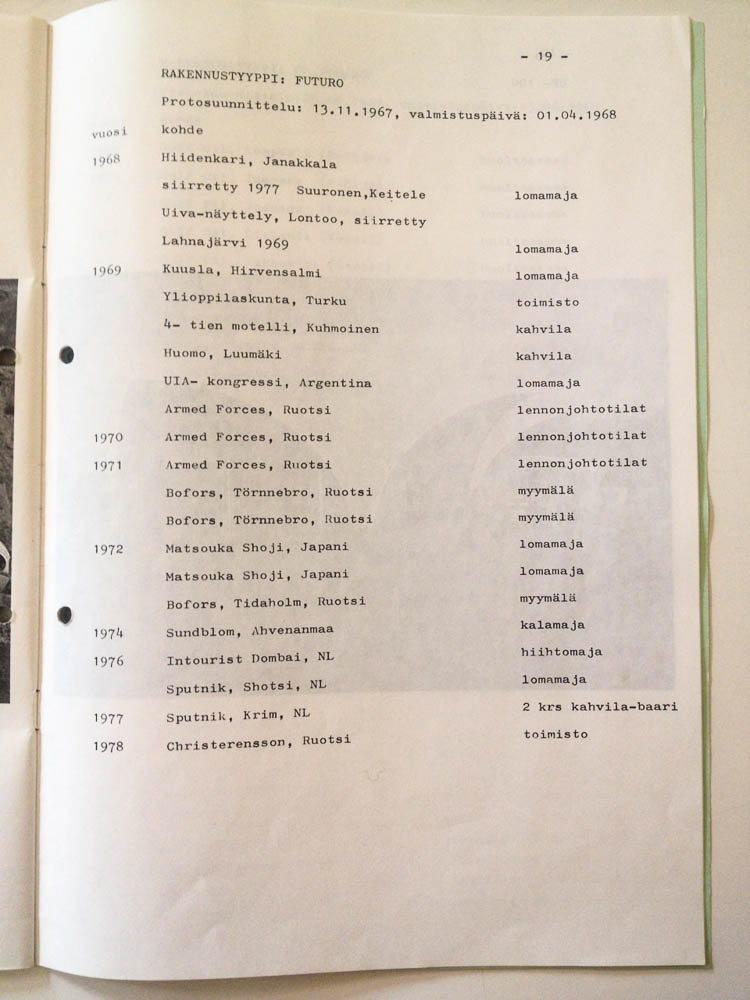
I assume the record above to be slightly mistaken, though. There is no Japanese word which is written ‘Matsouka’. More likely is ‘Matsuoka Shoji’ – or ‘Matsuoka Corporation’. A quick search pulls up a corporate website called ‘Uchu Center‘ or ‘Space Center’ which lists various facilities and Pachinko Parlours. Still in business and run by Eikichi Matsuoka.
Coincidence? I doubt it! Seems likely the boss has a bit of a space fetish. Perhaps this company bought the two Futuro intending to use them to promote its entertainment centers?
We can only speculate at this point forward. Even Simon, having discussed with Marko Home, has not been able to find out much about the story before this point. More research is needed to dig deeper! (Massive thanks to you, Simon, for all your help and correspondence so far!)
And that, dear reader, is about as far as we’re able to come today on our journey visiting Japan’s lost Futuro house.
Does the Felica Academy know the backstory? How is Mr. Matsuoka doing? And why is the Futuro sitting left to rot!?
Questions, questions.
One thing I do know after my exposé on the Royal House Mystery – the story is never complete!









Was it explorative architecture? Was it lightweight structure being tested for building use? Or a UFO-inspired attempt just for fun? Did other studies follow?
Hi there, great story. Really impressed by your detective skills. Can you share the location of the Futuro in the woods?
Thanks for the story.
Great detective work and fantastic way of telling the story! I usually read you mostly because of the Japanese content, as Japan’s language and culture is what interests me and first brought me to you site. Nonetheless you really captured my attention and I was there biting into my nails, in the wood looking for the futuro haikyo!
Keep up writing and sharing your experiences and adventures, please! I loved every minute of it!
Please tell me the exact coordinates of FUTORO
So often, the story of haikyo – or abandoned structures anywhere – is left to the imagination, or perhaps the deductive skills of the explorer examining the site. And while it’s fun and entertaining to imagine the people and activities which may have occurred at the place of ruins, it’s more satisfying still to encounter the facts, even if these facts are nothing more than the average and pedestrian realities of life. With this post, Michael shares not only the facts of a very unique abandoned place, but also the story and background which fill in the big picture, and which help us to imagine the people and motivations which brought not only this unique architectural oddity into being, but caused it to exist in so remote and unlikely place as the countryside of Japan. Of particular interest to me were the old marketing photos, which helped me to see what the structure and interior may have been like when new. Reading this post, I felt like I’d been taken on a long journey across continents and time to a secret few might ever know as anything more than a mystery. Thank you for that…
Great detective work!
I could see myself living in there, at least the version comprising a large bed and without the fireplace. I would just put an upholstered bench in place of the reclining seats and use retro pastels colors, rather than blue and red. Maybe one of the reasons people didn’t really feel like living in these buildings was that a living space with that many windows didn’t feel very intimate ?